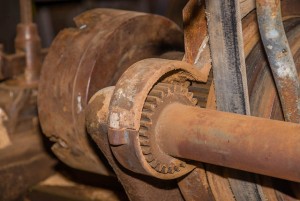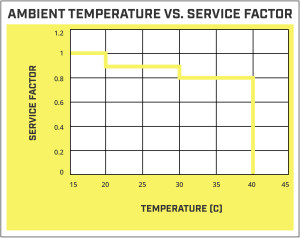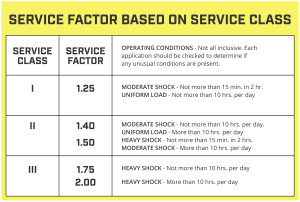 Before you choose a Falk gearbox for your application, be sure to know the difference between gearbox service factors and gearbox service class. Determining the appropriate service factor is the first step in selecting the right gearbox for your job.
Before you choose a Falk gearbox for your application, be sure to know the difference between gearbox service factors and gearbox service class. Determining the appropriate service factor is the first step in selecting the right gearbox for your job.
What is a Gearbox Service Factor?
A service factor is “the ratio of the gearbox rated horsepower (or torque) to the application’s required horsepower (or torque)”. It’s a numerical value that is assigned by the American Gear Manufacturers Association (AGMA), which takes into account the type of gearbox, the expected service duty, and the kind of application the gearbox will be used for.
Service factors are based on criteria that are gathered from extensive review and analysis of gearbox manufacturers’ experience with the operation of the gearbox.
For example, the rating for a gear tooth is based on its resistance to pitting, its durability, or its bending fatigue. As the service factor of the gearbox is increased, the relationship between the gear teeth life and the load is “proportional to the increase in service factor, raised to the 8.78 power.”
The service factor for your potential gearbox should be determined based on the conditions of the application and these factors:
- Non-uniform load
- Hours of service
- Elevated ambient temperature
- Frequent starts and stops
- High peak load versus continuous loads
- Extreme vibration
What is the Importance of Service Factor?
 Service factor is used to help determine whether or not the gearbox can handle the requirements of the application. The gearbox service factor is akin to a safety factor to help ensure that the gearbox meets the application requirements under typical operating conditions.
Service factor is used to help determine whether or not the gearbox can handle the requirements of the application. The gearbox service factor is akin to a safety factor to help ensure that the gearbox meets the application requirements under typical operating conditions.
Once typical conditions have been accounted for, then consider non-typical working conditions that may cause additional stress and wear on the gear teeth, the bearings, or lubrication. Any extra stress or wear should be accounted for while calculating the service factor to ensure a sufficient safety margin.
What Does Service Factor mean?
A service factor of 1.0 means that the gearbox can handle the application. For example, if an application needs 5,000 inch-pounds, a service factor of 1.0 means that the gearbox can handle 5,000 inch-pounds with no room for tolerance.
A service factor of 1.4 is adequate for most industrial applications. This allows for some leeway before the gearbox would overheat or fail. This would also allow for the flexibility that is sometimes needed onsite when performing jobs in changing environments, such as logging, mining, or other outdoor environments.
Choosing the right service factor can be the difference between having a gearbox that can perform the job while staying in the tolerated limits, and needing costly gearbox repairs.
Having a gearbox designer help choose or create the gearbox for your application can be very beneficial. Typical service factors don’t accommodate repetitive shock loading or serious critical vibrations, so a gearbox designer can identify and select the right drive for the project. By using an experienced designer, you can be sure to have a gearbox that can easily tolerate the conditions and not be stuck with a gearbox more powerful than the application would need.
What is Gearbox Service Class?
 A service class is another way some manufacturers cite the ability for a gearbox to fit the needs of a particular application. Generally, the service class corresponds with the service factor in this way:
A service class is another way some manufacturers cite the ability for a gearbox to fit the needs of a particular application. Generally, the service class corresponds with the service factor in this way:
- Service class, I = 1.25 Service factor
- Service class II = 1.40-1.50 Service factor
- Service class III = 1.75-2.00 Service factor
The service class is used for when manufacturers have gearboxes for general application types. They will also publish specific service factors for a specific application as well.
If you’re in search a Falk gearbox for your application or looking for repair or restoration services, contact the Mar-Dustrial team today.
Posted under Falk Gearboxes on Thursday, October 3rd, 2019
